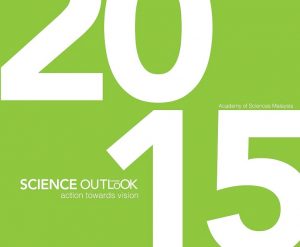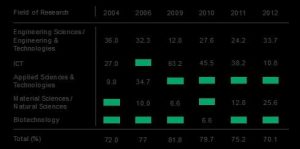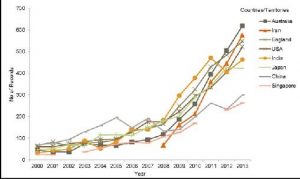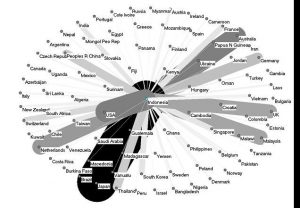Overview
Academy of Sciences Malaysia (ASM), which functions as the national STI Think Tank under the Ministry of Science, Technology and Innovation, was formed to promote STI agenda through various platforms and engagement with media, industry and societies. In 2015, ASM published its first Malaysia’s Science Outlook. The outlook, which serves as an official advisory document to the Malaysia’s policymakers, provides independent review of key trend in science, technology and innovation in Malaysia. The philosophy of the Science Outlook is to evaluate where Malaysia is in STI by benchmarking ourselves with other country that is advancing in STI, identify the gaps, consider future implications and recommend the way forward to realize Malaysia’s inspirations in STI. There are 6 pillars in the 2015 Science Outlook namely STI Governance, Research, Development and Commercialization, STI Talent, Energizing Industries, STI Enculturation and Strategic International Alliance. Preparation of the outlook involved many processes including stocktaking exercise to study the current trends and challenges in STI, data gathering and international peer review. This was followed by a thorough evaluation and gap analysis on various indicators of STI development.

Front Cover of Malaysia’s Science Outlook 2015
Having tabled the first Science Outlook at the Parliament, ASM realized that it is essential to produce a latest version of the document to update the policymakers on the current situation of the country with respect to STI. As an S&T Fellow who has been designated under ASM, I have been assigned to assist with the preparation of the Science Outlook 2016-2017. One of my specific tasks is to look into the preparation of one of the chapter namely Strategic International Alliance. Although international collaboration is being heralded as the hallmark of contemporary scientific production, little quantitative evidence has portrayed the landscape and trends of such collaboration. Policy makers are faced with questions of how to support, benefit from and exploit the collaborations. The need to enhance strategic international alliances was not articulated or highlighted in the initial STI frameworks (at least, until the current policy was introduced), as the focus has been primarily on building and strengthening national capabilities and capacity for research, technology and innovation.
Realizing this issue, the latest Science Outlook will look into collaboration trends among universities in Malaysia and their strategic partner, which lead to highly impactful papers published in international journals. Strategic International Alliances: Tapping into the Global Potential Collaborative partnership is a key factor in the growth of any country. A partner can provide capital, share resources or supplement one another’s expertise and strengths for their mutual benefits. Collaborative partnerships may also create significant obstacles in terms of the level of STI strengths, skilled and expert workers or different industry capabilities. Hence, it is important for Malaysia to target strategic partners such as ASEAN, BRIC (Brazil, Russia, India, China) and MIST (Mexico, Indonesia, South Korea, Turkey), which will eventually improve Malaysia’s image in STI capabilities.
Although the need to enhance strategic international alliances was not spelled out and emphasized and in the initial S&T frameworks as the focus has been primarily on building and strengthening national capabilities and capacity for research, technology and innovation, history has witnessed Malaysia’s commitment to collaborate, co-create and foster strategic partnerships for socio- economic growth through various MOUs, agreements and treaties in the S&T cooperation with high-potential partner countries. For instance, the “Look East Policy” (LEP) of Malaysia, introduced by YAB Dato’ Seri Dr. Mahathir Mohamad (Malaysia’s third Prime Minister) in 1982, allowed the country to forge partnerships with the likes of Japan and South Korea for the exchange of capital (both human and financial), goods and most importantly, a vision of a boundless future. The very premise on which the LEP took flight i.e. strategic international cooperation continues to be instrumental in the cross-pollination of people, products, processes, practices and principles of governance, while helping to forge new business and trade collaborations, even in S&T space.
With Malaysia’s liberalization and regional integration for business and trade, strategic international alliances will become extremely critical to further national interests and achieve the country’s aspiration to emerge as a developed economy. The successful implementation of our progressive policies will be determined by our ability to break all barriers of trade and the extent to which Malaysian industry is able to establish international partnerships to gain competitive advantages in local, regional and global marketplaces. Looking at the network of collaboration through publications and patents in ICT and biotechnology – the two top fields which dominated R&D allocation in Malaysia over the past several years (Table 1-1) – we can see that the Malaysian network of collaboration lacks international exposure (international collaborators), a factor that may limit its potential. The lack of international collaboration is affirmed based on a study (Gazni, A. et al., 2012) that has been conducted by as summarized in Table 1-2.

Table 1-1: Field of Research which Dominated Malaysia’s R&D Allocation (Source: MASTIC 2014, MOSTE 2003, MOSTI 2013)

Table 1-2: International Collaboration Across theMost Productive Countries of the World (Source: Gazni, A. et al., 2012)
Mapping Out International Collaboration: Malaysia’s PerspectiveCo-authorship publication is one of the good indicators to measure the effectiveness of strategic international collaboration. In Japan and China, it has been shown that the national publication systems have gained a synergy from foreign co-authorship relationships. Although Malaysia does not yet have such detail data, there is historical data in terms of research publication output that shows a trend of increasing collaborations between Malaysians and international researchers according to Thomson Reuters’ Web of Science database (Figure 1-3). Prior to 2008, Malaysia collaborated mostly with China, Japan and U.S., who remained amongst the top five countries for many years. As of 2013, Malaysia’s top three country collaborators in indexed research publications are Australia, Iran and England (Figure 1-4).

Figure 1-3: Malaysia’s indexed publication collaboration trend, 1981-2011 (Source: Science Outlook 2015)

Figure 1-4: Malaysia’s indexed publication collaboration by country, 2000-2013 (Source: Science Outlook 2015)
In the updated outlook, I proposed that we go a step ahead by mapping out the global scientific collaboration and networking by measuring the rate of collaboration at these levels using three indicators: average number of authors, institutions and countries per paper, plus the size of collaboration at different levels in different fields. I proposed and presented my idea during one of the earlier meeting on the preparation Strategic International Alliance Chapter. The proposed idea, which warmly welcomed and accepted by the committee member, will demonstrate the tendency toward research collaboration and patterns of collaboration among countries can be mapped and modeled based on step-by-step analysis as depicted in Figure 1-5.

Figure 1-5: Data Processing for Mapping Out International Collaboration(Source: Gazni, A. et al., 2012)
This will involve the study analysis of documents from ISI’s Web of Science (WoS). All documents regardless of type (e.g., article, meeting abstract, proceedings paper, review, editorial material, book review, letter, note, etc.) will be processed. Example of such mapping (a simpler version) is demonstrated in Figure 1-6. As depicted in the figure, the thicker and darker links between Indonesia and several particular countries (e.g. USA, Japan, Netherlands, etc.) indicates strong collaborations in term of joined-researched and co-authorship.

Figure 1-6: Map of Country-Specific (Indonesia) InternationalCo-authorship with Other Countries based on 1021 international co-authorship relations with authors in 86 other countries on the basis of 559 documents with an Indonesian address in 2011 (Source: Leydesdorff, L. et al., 2013)
The comprehensive results of this study which will be documented in the Science Outlook 2016-2017, which is aimed to inform scientific policy makers and scholars on the history and state-of-the-art in collaboration across multiple domains. Nonetheless, the primary driver of most collaboration should come from the scientists themselves. In developing high-quality research and finding answers to complex problems, scientists should seek to work with the best people, institutions and equipment, wherever they may be. The connections of people, through formal and informal channels, diaspora communities, virtual global networks and professional communities of shared interests are important drivers of continuous international collaboration.
Reference
Gazni, A.; Sugimoto, C. R. and Didegah, F. (2012). Mapping World Scientific Collaboration: Authors, Institutions, and Countries, Journal of The American Society for Information Science and Technology. 63(2): 323–335.
Loet Leydesdorff, Caroline Wagner,Han Woo Park,and Jonathan Adams (2013). Collaboration in Science: The Global Map and Network. https://arxiv.org/pdf/1301.0801.pdf
Malaysian Science and Technology Information Centre (MASTIC) 2014a, Malaysian Science, Technology & Innovation (STI) Indicators Report 2013, Ministry of Science, Technology and Innovation Malaysia (MOSTI), Putrajaya.
Ministry of Science, Technology and the Environment (MOSTE) 2003, The Second National Science and Technology Policy and Plan of Action. Ministry of Science, Technology and the Environment, Putrajaya.
Science Outlook 2015 (2015). Academy Sciences of Malaysia (ASM).
About the Author
Dr. Zainura Zainun Noor most recently worked as an Associate Professor at the Faculty of Chemical and Energy Engineering, Universiti Teknologi Malaysia. She has worked in both public and private sectors and led the Green Technology Research Group at the Center of Environmental Sustainability and Water Security. She is one of the Government of Malaysia’s consultants for several high-profile national projects namely the development of their Environmental Performance Index (EPI), Malaysia’s Clean City Program and MIT-UTM Malaysia Sustainable Cities Program (MSCP). She was also recently appointed by the United Nations Development Program to develop Vietnam’s EPI. Dr. Zainura holds a Bachelor’s Degree in Chemical and Environmental Engineering from Vanderbilt University in Tennessee in the United States (1998) and both a Master’s Degree in Clean Technology (2002) and Ph.D. in Chemical Engineering from Newcastle University in Newcastle-upon-Tyne in the United Kingdom (2006).
